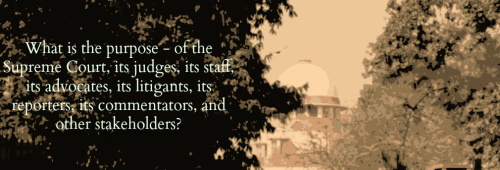One can imagine these words being uttered by a salesperson, or even printed in bold on an advertisement for the Delhi Police. It is not what one would, as a matter of fact, expect to hear in a court room; definitely not from the presiding judge.
Yet, remarkably, in the Registrar’s Court No. 2 a few days ago, when a petitioner-in-person lost his cool — agitated and frustrated that his case would again not be listed before the Supreme Court for hearing because service of documents was not complete on all respondents — these simple words were what the presiding judge had for him.
These words are remarkable, not because the presiding judge sensibly preferred them over a stern rebuke to the petitioner-in-person for violating the decorum of the Court, nor simply because they demonstrate an acknowledgement of the emotional pitfalls of litigation, especially for those courageous enough to fight their own cases without a lawyer; these words are remarkable because they force all of us to examine the question “What are we here for?”
What is the purpose – of the Supreme Court, its judges, its staff, its advocates, its litigants, its reporters, its commentators, and other stakeholders? In assessing our respective roles in the administration of justice, is there a lens we can use that is not teleological, and if not, what does this lens show us?
Au contraire, are we fooling ourselves by evoking a singular, grand purpose of participation in the administration of justice for all players, if only because such a purpose is a Sisyphean one? Perhaps it is more appropriate to accept that the administration of justice is nobody’s responsibility. Things are what they are for no cause attributable to anybody in particular. Therefore, individual actors need not be mindful of their actions beyond their explicit obligations.
By referring to current judgments and institutional developments at the Supreme Court, as well as opinions, comment and anecdotes, this fortnightly blog will offer a space for reflection.
If you are in any way associated with the Supreme Court, chances are that your association has lasted longer than mine (barely a year now). Your thoughts, suggestions, and — I hope there will be no need for these — corrections, are most welcome.
Next fortnight
Have you tried the Supreme Court’s Android app?
5, 2, 1, 3, 4, 14, 12, 10, 8, 6, 7, 9, 11, 13, 15 – if these numbers mean nothing to you, you are yet to take your first steps in decoding the Supreme Court’s institutional grammar.
(Aditya Verma practices as an Advocate at the Supreme Court of India. He is an alumnus of NLSIU, Bangalore, and is admitted as a solicitor in England and Wales.)



2 replies on “What are we here for?”
Do you think ‘we are here to serve you’ could have been better? Would ‘serve’ reflect more humility and less pride?
Is our communication shaped by our attitude?
What should a common man expect of public servants: help or service?
Good point. But how about looking at it this way: at most institutions (worldwide), the reception / helpdesk will say “May I help you” or “How may I help”. Same for customer care centers. The use of “May I serve …” is typically seen in restaurants. Maybe the judge used “help” without much thought and his choice of the word “help” was prompted by what his subconscious has registered from past experiences at private sector outlets, where he felt good to see that people were there to help him (in effect, those people were serving him).